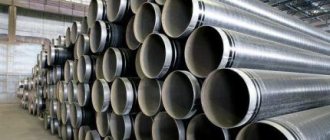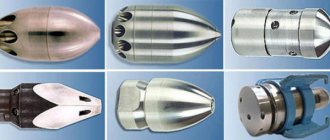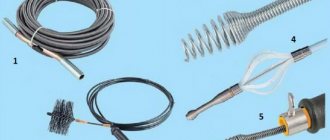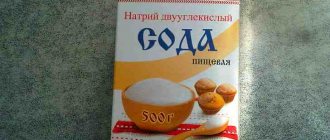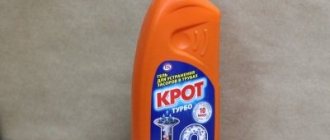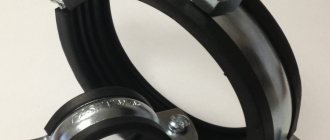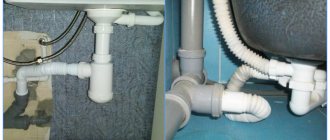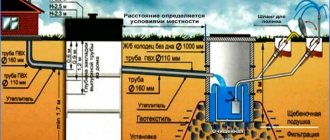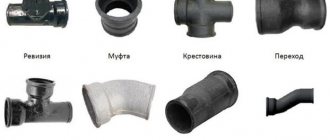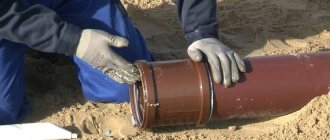One of the unpredictable moments that happen in everyday life is the formation of pollution and clogs in sewer pipes. This happens unexpectedly and becomes a real test for the owners. For quick and easy access to such areas of the sewer system and removal of blockages, it is planned to install so-called cleaning and inspection systems in the communications. This is the only proven way to restore the pipeline's continued functionality. In order not to confuse these two definitions, and to understand them, you need to understand their differences.
ATTENTION! A unique, highly effective product has been developed for cleaning sewer pipes, eliminating any blockages. The product is a concentrated mixture of enzymes that easily break down and process fat accumulations and any deposits of organic origin. One package of Saniclean will last you a whole year! Read more"
Definition of "cleansing"
This is a tee at an angle of 90 or 135 degrees, with one or two bends and with a kind of window at the end of the pipe. The tee is closed on top with a sealed lid on mastic. For unhindered work on removing blockages, the lid opens and through the hole that appears, pockets of contamination are removed. The cleaning hatch is made of polypropylene or polyvinyl chloride. The same material is used in the production of sewer pipes. The hatch comes in two types: gray and orange. Gray for installation inside buildings, orange for outside. When choosing it, you need to be guided by the diameter of the sewer pipes.
Features of polypropylene products
The sewer inspection is a kind of tee. One of the outlets of this fitting is hermetically sealed with a lid. This prevents leakage.
When purchasing a sewer inspection, you should inspect it for integrity
If necessary, it can be removed in order to check and clean it.
You won’t have to look for a blockage for a long time after installation, since there is a short distance between inspection points in accordance with the standards. Before choosing the size of the clearings, decide on the diameter. Steel and cast iron revisions are no longer in demand these days. Polypropylene and plastic revisions are available in three standard sizes with a diameter of 50 mm, 75 mm and 110 mm. At high pressure, polymer elements can operate in pressure and gravity drainage systems. Polymer cleaners are installed on those pipelines that are made of polyvinyl chloride. Their installation can be done in horizontal and vertical planes.
The main advantages of polymer revisions:
- Weight – shaped elements are much lighter than steel or cast iron fittings;
- Frost resistance – at low temperatures, fittings retain their properties;
- Durability – polypropylene revisions are plastic and are not afraid of impacts.
Such fittings are used to drain risers of various origins, even those that contain aggressive chemical substances.
Definition of "revision"
It is a separate shaped part of the pipe, with a small window located in its side. If contamination suddenly occurs, through the hole you can easily see the causes of the plug and take further steps to eliminate the problem.
Differences
The main differences between cleaning and revision:
- Audit is inspection and control, and cleaning is elimination and elimination of consequences;
- It is installed, as a rule, in vertical distribution in technical niches of buildings and in horizontal (in the floor), and cleaning is only done in the horizontal section;
- With the installation of an inspection, the communication pipeline is cleaned in two directions, and with the hatch in one direction.
If the installation of the inspection is carried out correctly, it provides several observation points: at pipe turns, on all risers of the building, near the riser indents and at the exit from the basement (the coldest area).
Main causes of clogging
During the operation of a communication system of this type, fatty deposits very often appear on the surface of pipelines, which leads to a decrease in throughput. Ingress of hair, sand, animal fur and other large debris greatly aggravates the situation.
However, clogged pipes can be not only a consequence of improper operation:
- the presence of sharp and right angles in the drainage network usually leads to the formation of frequent blockages;
- poorly connected pipes with a large number of burrs can cause blockages;
- the huge number of turns also impairs the functioning of the system, leading in some cases to the formation of debris jams.
Such contaminants may appear inside pipelines.
Installation of the cleaning hatch
If there is little water flow in the bathroom, the sink is clogged, or there is an unpleasant smell in the kitchen that cannot be removed with a freshener, you need to act immediately. With the help of Saniclean you can easily cope with the situation without a plumber... Read more»
If the communication pipes are correctly laid out by a competent specialist, they are necessarily equipped with cleaning hatches. Their main purpose is to quickly remove dirt and blockages from plumbing drains.
The most common place for installing hatches is the lower floors of buildings, especially they are in demand in the private sector. They are also installed in places where the pipeline turns, if the angle exceeds 30 degrees. If the pipe diameter is 10 cm, they are installed every 15 meters, if the diameter is larger - every 30 meters. The hatch is located both outside the house and inside the room and it must be easily accessible.
If a blockage has formed in the communication pipes, and there is no cleaning, in order to reach the blockage, you will need to dismantle the pipe. Installation work must be carried out at positive temperatures.
Connecting the cleaning device to a damaged pipe is not allowed. When installing hatches, take into account the availability of sufficient surrounding space for convenient cleaning work.
Liquid and gel products
This form of release is the most common.
Liquid and gel remedies for clogged pipes:
- "Sanfor"
- "Tiret Turbo"
- "Deboucher"
No. 1. "Sanfor"
Product of the Year 2021. Available in the form of a 750 ml gel. The thick consistency pushes out water and penetrates the clog, eating away the debris. Poured into the sewer system. After an hour and a half, the pipes are spilled with hot water.
No. 2. "Tiret Turbo"
For home use it is used without the “Professional” mark. The difference lies in the composition of the product. In domestic conditions, ventilation of premises is not required. The heavy gel, moving through the pipe, reaches the blockage even in standing water. Disposable volume for cleaning - 250 ml. facilities.
No. 3. "Deboucher"
The components included in the composition cope with various types of contaminants. Feature - not used in aluminum pipes. Eliminates unpleasant odors, the result appears in 1-2 hours. The downside is that it costs a lot of money. A single serving is 500 ml.
Preparing for sewer cleaning
When sewer pipes become clogged, effective means to achieve a positive result are: an electric drill, a rope drill or steel wire. Cleaning begins in the following order:
- You can determine the location of the plug by lightly tapping (if you have access to a communication sewer). A dull sound will occur at the location of the plug and a little higher;
- If access to the pipe is difficult or it is located in the floor (with horizontal sewerage), the location of the blockage is determined by checking the inspection hatches;
- You need to start cleaning the pipes by getting as close as possible to the formation of a blockage (by determining the location of the nearest hatch);
- It is necessary to eliminate contamination in the hatch that is directly connected to the problem area;
- Wait a while (after the last use of the sewer). Because when cleaning the bottom hatch, above which drains have accumulated, stagnant dirty water may gush out.
Prevention
Everyone knows that it is easier to prevent a problem than to spend a lot of effort and money on eliminating it. Timely prevention of pipe contamination will help with this. We recommend:
- Purchase special plastic or metal mesh for the drain hole. They will prevent debris from entering the channel;
- From time to time (at least 1-2 times a year) it is worth disassembling and washing, degreasing the pipeline and its connecting elements;
- Open the hot water tap several times a week and flush the system. This simple method will help protect the sewer from large accumulations of fat;
- Under no circumstances should you throw away even small waste, as it can become the basis for the formation of a fat plug.
It is also important to remember about chemical cleaning agents, which serve as good protection against contamination. This method is effective for preventing blockages of organic origin. There is a large selection of such products, which can be divided by consistency: gel-like, liquid, granular and powdery. Their composition varies, but all options are based on a strong acid or alkali. The most popular remedy was and remains “Mole”, which is based on sodium hydroxide. Therefore, it is not recommended to use it for cleaning plastic pipes, since alkali destroys the structure of the material. For such cases, it is better to use gel-like products, they are more gentle.
We must not forget about effective folk recipes. For organic contamination you can use:
- Soda with vinegar . Pour a glass of soda into the drain hole, add a glass of vinegar. When the foam starts to rise, you need to close the hole and leave for a couple of hours. Then rinse with boiling water. If the water does not drain well, repeat the procedure;
- Soda with salt . Mix in equal quantities, add and pour in a small amount of water so that it helps move the mixture to the site of the blockage. Leave for 10-12 hours. After the time has passed, rinse with hot water until it begins to flow normally.
- Soda . Best suited for clearing clogged toilets. Dissolve about 250 g in a bucket of hot water and pour it into the toilet. We wait 2 hours and wash it off.
How to properly clean a drain in a manhole
This in itself is unpleasant and “untidy” work. To properly prepare the area for cleaning, you must:
- Prepare a lot of old rags and newspapers at the work site. When unscrewing the screws on the hatch cover, waste water may suddenly flow out. Indispensable household items will quickly help you deal with this: a mop, a rag and a bucket. The more rags, the better, this will simplify further cleaning after the consequences of cleaning;
- Remove the cover and move the rotational movements of the rotor or steel wire in the direction of the blockage in order to crush its integral structure into several small parts;
- Clean the pipes from any remaining lumps of dirt using a strong stream of water from a hose. Sewer pipes are laid on a slope, so they need to be flushed out of a hatch located above the blockage.
- If there is no positive cleaning result, you can try to act in the same way, but from the inspection hatch located below the resulting dirt plug.
Types of nozzles for washing
There are different types of nozzles through which water is supplied under pressure. The choice is made depending on the type of contaminants that you plan to get rid of.
Nozzle options:
- Universal (reactive). This is a standard type of nozzle and does not have a front nozzle. Used to remove small plugs and flush pipelines.
- Punchy. The nozzle is of a standard shape and has a front nozzle. Suitable for removing large plugs of debris, grease or ice.
- Donnaya. Wedge-shaped nozzle. Used to remove silt deposits from the bottom of a pipe or channel.
- Chain. Such nozzles are available in different shapes - triangular, spiral, toothed, each with up to 4 nozzles directed forward. Used to break large hardened plugs.
- Corner. This is a flexible version of the nozzle, consisting of individual links. Used for cleaning pipelines of complex shapes and siphons.
- Rotary-vibration. Nozzle with a displaced center of gravity and a rotational part. Used to remove mineral deposits, used where cutting attachments cannot be used.
